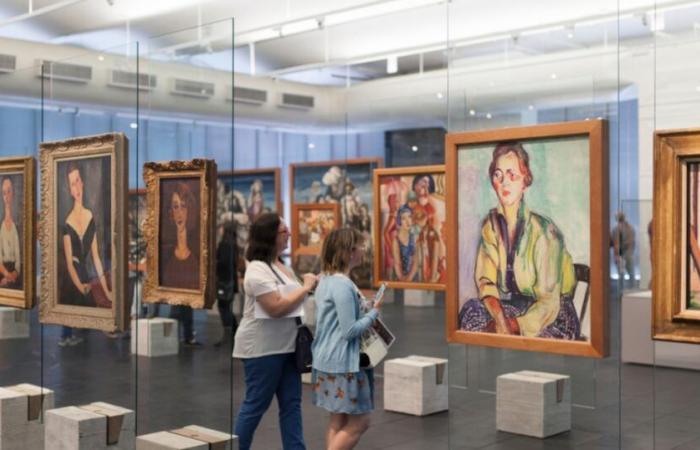It’s Friday afternoon in São Paulo. Through the car window, Paulista Avenue appears, a nerve point of a syncretic, frantic city with twelve million inhabitants. The variety of styles overwhelms. A short time ago, Pablo Ramírez, the Argentine designer who created the costumes for the starting of the Opera Carmen of the Municipal Theater, explained it as an “unbarkable” territory.
It’s true: all descriptions are obvious, they fall short. São Paulo does not explain her, the words do not fit.
Reaching Soho House (Rua São Carlos Do Pinhal 764), a social club and hotel in the Bela Vista neighborhood that works in an Italian neoclassical building of the twentieth century – the old maternity pavilion of a historic hospital founded by the French businessman Antonio Maria Matarazzo. We do the fast check-in, technical stop through the room. At the bar, it’s The spicy, a cocktail made with tequila, juice of Lima and Chile. Pica fair, what is necessary. And so, a cup in hand, in a bar under “pernas, pra that I want!”, A mural for the Brazilian artist Marcelo Cipis, these 48 hours begin in São Paulo.

We ask for several ubers, we are a large group: a lot of logistics. It’s ten minutes to Dōmoa Japanese bar and restaurant of vinyl in Rua Major Sertório 452, Vila Buarque. The place is minimal, net, with few tables and a narrow bar. We ask for everything to share –yakitori, dumplings, Korean Spicy Noodles-and author drinks (Zum-Zum, 14 bis). It touches a Dutch DJ, the energy is high. We decided to lower the revolutions: on Saturday, our only whole day there, it will be long.
Saturday
Fast coffee in the Garden of Soho House. We go to him MASP, El Museo Art of São Paulo (Paulista 1578). Along the way, about three hundred meters on foot, we cross a street stall with music –samba– at full volume, streets full of pedestrians, couples kissing on the street.

We start with the permanent collection. One of the owners of the Barrakesh gallery in Buenos Aires accompanies us on the trip and officia of Guide.
The works are suspended on tempered glass plates anchored in concrete: he says that it is a system devised by Lina Bo Bardi, the architect-reebrity that projected the building in the ’60s, and retaken by Adriano Pedrosa, the artistic director of the Museum and curator of the last Venice Biennial, where he replied this same assembly system. It is radical: they dialogue, floating, disgusting, contemporary Brazilian artists such as Leda Catunda, Denilson Baniwa Y Dalton Paula with the big names of the European canon.
We travel temporary exhibitions where a video installation stands out in which Lina Bo Bardi itself talks about the concept behind the MASP architectural project and a painting sample by Hulda Guzmán, a Dominican artist who represents tropical scenarios of Latin American magical realism.
Another ten, fifteen minutes in car and we arrive at Peanuta restaurant with a Michelin star led by chef Helena Rizzo that is located in the Jardim Paulistano neighborhood (Rua Joaquim Antunes 210) and that combines Brazilian ingredients – mostly organic – with contemporary technique. As in every good lunchbetween shared dishes, some bottles of wine and dessert accompanied by coffee, The notion of time is lost. We have to run.

To the gallery Mendes Wood (Rua Barra founded 216) We arrived at the time. We travel “1 meter of Cabelo”, a sample of the Brazilian Adriano Costa that brings together sculptures and facilities that dialogue with the Queer culture and the Brazilian history. Twenty minutes by car and the hotel hotel. It’s rest time.
We left the purchases we made at the MASP Boutique – Books – and we prepared to go to Kuro, the Japanese “star” restaurant of chef Gerard Barberan which is located in Rua Father João Manuel 712 and offers an Omakase menu for only ten guests per shift. The largest Japanese community outside Japan is located in São Paulo in the Liberdade neighborhood: it is not surprising, in the light of that, the preeminence of Japanese gastronomy in the city.
Snail (Rua Boracea 160) To finish the night, a space dedicated to the Music with a restaurant and listening bar on the first floor and a club that receives electronic music DJs around the world in the second. It gets late, once again we force ourselves to go to sleep.

Domingo
We start at noon: 20 minutes of car. We get off Hiráa Japanese izakaya in Rua Fradique Coutinho 1240 in Vila Madalena, for lunch and almost when it is about to close. We ask for a ramen, a lemonade from Sakura to recover energy. They are the last hours in São Paulo.
We travel to him MOREIRA SALLES INSTITUTE In Paulista 2424 Avenue, about ten or less blocks from our hotel, and we visited “Imaginário Archipélago”, a sample that proposes an essay reading of the Paranaense photographer’s file Luiz Braga.
We walk back. In the street everything is gray and is green. There is sun before our arrival they say it rained. Before going to the airport, the wait is in the hotel garden with coffee and brigadeiros.







